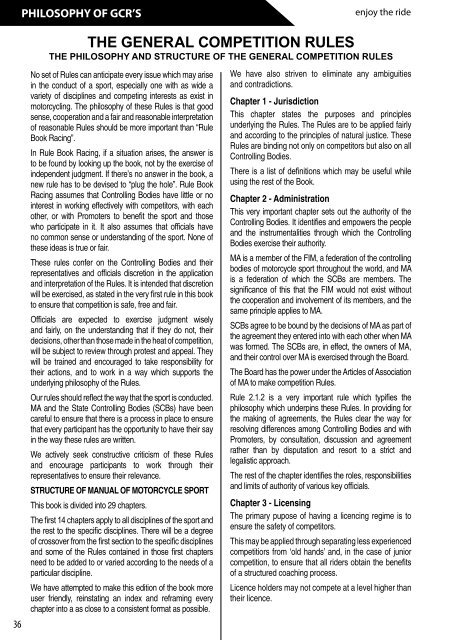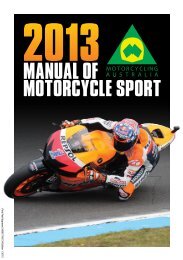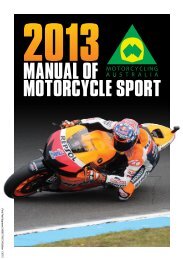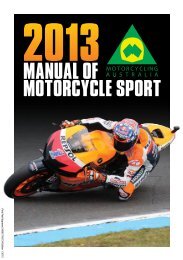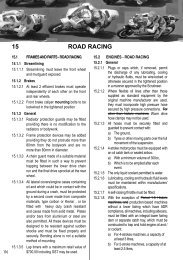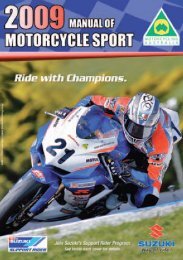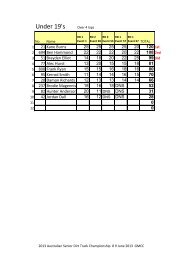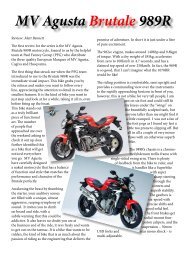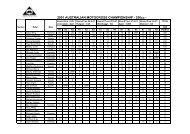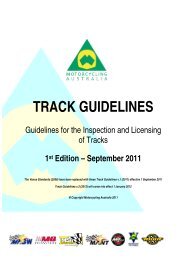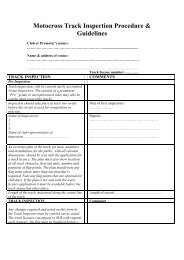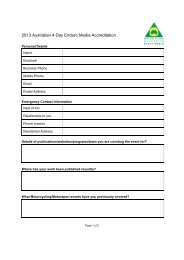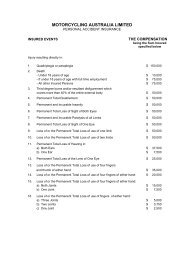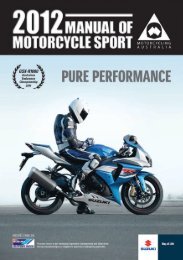MANUAL OF MOTORCYCLE SPORT - Motorcycling Australia
MANUAL OF MOTORCYCLE SPORT - Motorcycling Australia
MANUAL OF MOTORCYCLE SPORT - Motorcycling Australia
Create successful ePaper yourself
Turn your PDF publications into a flip-book with our unique Google optimized e-Paper software.
PHILOSOPHY <strong>OF</strong> GCR’S<br />
enjoy the ride<br />
36<br />
THE GENERAL COMPETITION RULES<br />
THE PHILOSOPHY AND STRUCTURE <strong>OF</strong> THE GENERAL COMPETITION RULES<br />
No set of Rules can anticipate every issue which may arise<br />
in the conduct of a sport, especially one with as wide a<br />
variety of disciplines and competing interests as exist in<br />
motorcycling. The philosophy of these Rules is that good<br />
sense, cooperation and a fair and reasonable interpretation<br />
of reasonable Rules should be more important than “Rule<br />
Book Racing”.<br />
In Rule Book Racing, if a situation arises, the answer is<br />
to be found by looking up the book, not by the exercise of<br />
independent judgment. If there’s no answer in the book, a<br />
new rule has to be devised to “plug the hole”. Rule Book<br />
Racing assumes that Controlling Bodies have little or no<br />
interest in working effectively with competitors, with each<br />
other, or with Promoters to benefit the sport and those<br />
who participate in it. It also assumes that officials have<br />
no common sense or understanding of the sport. None of<br />
these ideas is true or fair.<br />
These rules confer on the Controlling Bodies and their<br />
representatives and officials discretion in the application<br />
and interpretation of the Rules. It is intended that discretion<br />
will be exercised, as stated in the very first rule in this book<br />
to ensure that competition is safe, free and fair.<br />
Officials are expected to exercise judgment wisely<br />
and fairly, on the understanding that if they do not, their<br />
decisions, other than those made in the heat of competition,<br />
will be subject to review through protest and appeal. They<br />
will be trained and encouraged to take responsibility for<br />
their actions, and to work in a way which supports the<br />
underlying philosophy of the Rules.<br />
Our rules should reflect the way that the sport is conducted.<br />
MA and the State Controlling Bodies (SCBs) have been<br />
careful to ensure that there is a process in place to ensure<br />
that every participant has the opportunity to have their say<br />
in the way these rules are written.<br />
We actively seek constructive criticism of these Rules<br />
and encourage participants to work through their<br />
representatives to ensure their relevance.<br />
STRUCTURE <strong>OF</strong> <strong>MANUAL</strong> <strong>OF</strong> <strong>MOTORCYCLE</strong> <strong>SPORT</strong><br />
This book is divided into 29 chapters.<br />
The first 14 chapters apply to all disciplines of the sport and<br />
the rest to the specific disciplines. There will be a degree<br />
of crossover from the first section to the specific disciplines<br />
and some of the Rules contained in those first chapters<br />
need to be added to or varied according to the needs of a<br />
particular discipline.<br />
We have attempted to make this edition of the book more<br />
user friendly, reinstating an index and reframing every<br />
chapter into a as close to a consistent format as possible.<br />
We have also striven to eliminate any ambiguities<br />
and contradictions.<br />
Chapter 1 - Jurisdiction<br />
This chapter states the purposes and principles<br />
underlying the Rules. The Rules are to be applied fairly<br />
and according to the principles of natural justice. These<br />
Rules are binding not only on competitors but also on all<br />
Controlling Bodies.<br />
There is a list of definitions which may be useful while<br />
using the rest of the Book.<br />
Chapter 2 - Administration<br />
This very important chapter sets out the authority of the<br />
Controlling Bodies. It identifies and empowers the people<br />
and the instrumentalities through which the Controlling<br />
Bodies exercise their authority.<br />
MA is a member of the FIM, a federation of the controlling<br />
bodies of motorcycle sport throughout the world, and MA<br />
is a federation of which the SCBs are members. The<br />
significance of this that the FIM would not exist without<br />
the cooperation and involvement of its members, and the<br />
same principle applies to MA.<br />
SCBs agree to be bound by the decisions of MA as part of<br />
the agreement they entered into with each other when MA<br />
was formed. The SCBs are, in effect, the owners of MA,<br />
and their control over MA is exercised through the Board.<br />
The Board has the power under the Articles of Association<br />
of MA to make competition Rules.<br />
Rule 2.1.2 is a very important rule which typifies the<br />
philosophy which underpins these Rules. In providing for<br />
the making of agreements, the Rules clear the way for<br />
resolving differences among Controlling Bodies and with<br />
Promoters, by consultation, discussion and agreement<br />
rather than by disputation and resort to a strict and<br />
legalistic approach.<br />
The rest of the chapter identifies the roles, responsibilities<br />
and limits of authority of various key officials.<br />
Chapter 3 - Licensing<br />
The primary pupose of having a licencing regime is to<br />
ensure the safety of competitors.<br />
This may be applied through separating less experienced<br />
competitiors from ‘old hands’ and, in the case of junior<br />
competition, to ensure that all riders obtain the benefits<br />
of a structured coaching process.<br />
Licence holders may not compete at a level higher than<br />
their licence.


